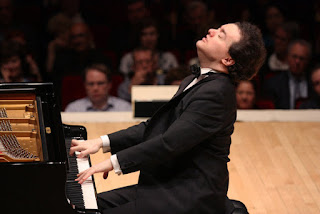RUSSIAN-BORN MASTER OF ROMANTIC REPERTOIRE IN QUASI- 'FAREWELL' US TOUR DRAWS RECORD CROWDS
by Dwight Casimere
Photo: Hiroyuki Ito/New York Times
NEW YORK--Evgeny Kissin is appearing at Carnegie Hall in two sold-out recitals this week, the first pianist to perform dual concerts there in a single week since Vladimir Horowitz in 1979. His first performance brought record attendance, prompting the seating of more than a hundred lucky patrons onstage. An encore performance will be heard on Friday, November 6 at 8pm. For more information, visit carnegiehall.org.
Evgeny Kissin's program of Mozart, Beethoven and Brahms and the Spanish composers Albeniz, Larregla and possible encores of Granados, will be heard at Chicago's Symphony Center Sunday, November 15 at 2pm. For information, visit cso.org.
In his Carnegie Hall performance, the enthusiastic audience literally enveloped onstage and off as he strode onstage before the capacity crowd. He got directly to the business at hand, delivering a concise reading of Wolfgang Amadeus Mozart's Piano Sonata in C Major. His deft fingering layed out the playful opening melody with a light touch that allowed him to gently increase its intensity. Accompanying themes grew more defined in the left hand as the first movement, Allegro moderato unfolded.
The most exquisite moments were to follow in the Andante cantabile in which he allowed the central theme to literally sing forth, filling the acoustically perfect space with the most celestial of sounds. The Allegretto literally danced beneath his lithe touch, which ended with a graceful flourish.
Kissin seemed most at home with Beethoven's Piano Sonata No. 23, appropriately named "Apassionata." Kissin found the beating heart of this masterpiece of the Romantic piano repertoire. There was long and artful development of the central thematic line of the Allegro assai, building to a crescendo that burst, then faded like fireworks against a nighttime sky. Andante con moto was more dance-like with spirited movement, just as Beethoven intended. Again, Kissin's strong fingers brought forth the light quick-step of the melody while conveying a sense of the dramatic elements to follow. He pulled out all the stops in the final movement, Allegro ma non troppo (fast, but not too fast), was Kissin's opportunity to showcase the full dynamic force of his playing. At first restrained, building the increasingly complex thematic material in the left hand, while executing beautifully embellished cascading arpeggios in the right. It all erupted in a dazzling display of virtuosic prowess.
Following the interval, Kissin bore his Romantic soul in Johannes Brahms' Three Intermezzos. His contemporaries referred to them as a "fountain of pleasure....filled with "poetry, passion, rapture and heartfelt emotion." Kissing summoned forth all that and more in his performance. He leaned forward, hovering above the keys as if listening patiently for the soul of the music's creator to speak to him. The emotions he conjured forth were thusly heartfelt. There was a bittersweet quality to his playing that almost brought one to tears.
Isaac Albeniz' tone poems Granada, Cadiz, Cordoba and Astorias are the Spanish composer's version of tone poems, evoking the sights and sounds of his homeland. Awash in impressionistic tonal brush-strokes, Kissin used his considerable skills to paint a musical portrait as only he can do.
The ensuing encores of fellow Spanish composer Enrique Granados; Quejas o la maja y el ruisenor, Andaluza and Brahms' familiar Hungarian Dance, No. 1, had them figuratively dancing in the aisles as the happy and satisfied audience made its way toward the exits.
This program repeats Friday, November 6 at 8pm at Carnegie Hall.
Photo: Hiroyuki Ito/New York Times



No comments:
Post a Comment